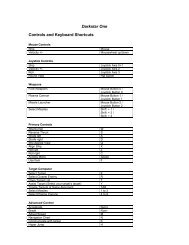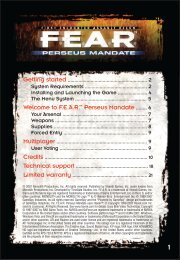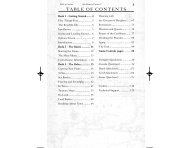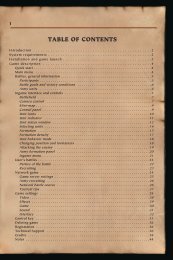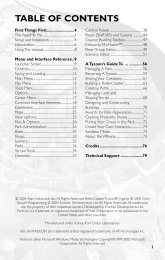Heads-Up Display Modes 35 - Metaboli
Heads-Up Display Modes 35 - Metaboli
Heads-Up Display Modes 35 - Metaboli
Create successful ePaper yourself
Turn your PDF publications into a flip-book with our unique Google optimized e-Paper software.
Air-to-Ground Weapons 105<br />
Unguided Rockets<br />
Despite the existence of high-accuracy weapons, unguided rockets remain a<br />
powerful and flexible air-to-ground weapon, combining high combat efficiency and<br />
simplicity of use with low cost. An unguided rocket has a relatively simple design<br />
and consists of a fuse and a warhead in the nose part followed by the rocket body<br />
with a solid-propellant motor and stabilizer. Unguided rockets are usually placed in<br />
special rocket pods.<br />
The rocket motor begins to operate at the moment of launch. Due to thrust<br />
provided by the motor, which usually operates from 0.7 to 1.1 seconds depending<br />
on the rocket type, the rocket accelerates to 2100–2800 km/h. After the motor<br />
burns out, the rocket coasts, gradually slowing down because of air resistance.<br />
Like a projectile, the unguided rocket follows a ballistic trajectory. To provide steady<br />
flight, a rocket has a stabilizer located in its tail part. It serves to align the<br />
longitudinal axis of the rocket with its velocity vector. As unguided rockets are<br />
usually carried in launching pods, the stabilizer fins are kept folded inside the<br />
launch tubes of the pod. When the pilot launches the rocket, the stabilizer fins flip<br />
out into a fixed position.<br />
Some types of unguided rockets stabilize by spinning themselves about the<br />
longitudinal axis. To spin, a rocket can utilize specially shaped stabilizer fins (for<br />
small caliber rockets), or rifled nozzles in the launch tubes. Angular velocity of<br />
rotation ranges between 450 rpm and 1500 rpm and develops within a short<br />
interval after the launch.<br />
Depending on combat tasks, the pilot can employ unguided rockets of different<br />
caliber (from 57mm up to 370mm in diameter), fitted with fuses and warheads of<br />
appropriate types. A fuse can detonate on hitting the target, as, for example, in<br />
the case of an armor-piercing warhead, or at a certain distance from the launching<br />
platform, as in the case of a flare warhead.<br />
Hit accuracy is characterized by an effective range, which depends on the type of<br />
unguided rocket. Since a rocket flies without any guidance, its accuracy decreases<br />
as the distance to the target increases.<br />
Each type of unguided rocket has a specific possible launch zone limited by<br />
effective launch range and by safety range. The safety range depends on the<br />
warhead type and weight and should prevent the launching aircraft from being<br />
damaged by the debris after the warhead explosion.<br />
The pilot mostly employs unguided rockets at airspeeds of 600-1000 km/h while<br />
diving 10–30°. By maneuvering the aircraft, the pilot should line up on the target.<br />
Before the aircraft enters the rocket launch envelope, the pilot should place the<br />
aiming reticle on the target and, on entering the launch envelope, pull the trigger<br />
to launch.<br />
S-8 Rocket<br />
The S-8 is a medium-caliber, unguided rocket (80mm in diameter) placed into the<br />
twenty-canister B-8 rocket pod. The S-8 has an effective range of 2000 m. The<br />
margin of error is roughly 0.3% of launch range; rockets fired at a range of<br />
2000 m hit within a circle of 6 m in diameter. The S-8 is normally deployed with a<br />
shaped-charge fragmentation warhead effective against soft targets. Armorpiercing<br />
(capable of penetrating 0.8m of reinforced concrete) and fragmentation<br />
warheads are also available.





